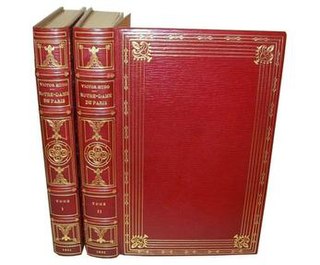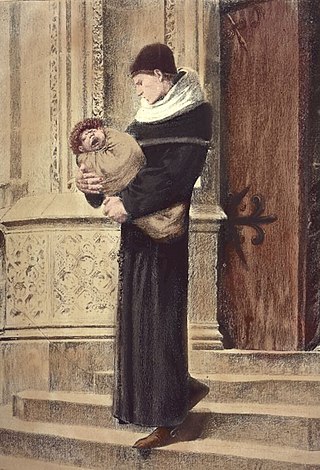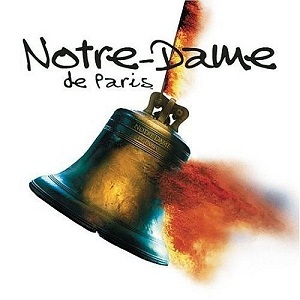
The Hunchback of Notre-Dame is a French Gothic novel by Victor Hugo, published in 1831. The title refers to the Notre-Dame Cathedral, which features prominently throughout the novel. It focuses on the unfortunate story of Quasimodo, the Roma street dancer Esmeralda and Quasimodo's guardian the Archdeacon Claude Frollo in 15th-century Paris. All its elements—the Renaissance setting, impossible love affairs and marginalized characters—make the work a model of the literary themes of Romanticism.

The Hunchback of Notre Dame is a 1996 American animated musical drama film produced by Walt Disney Feature Animation and released by Walt Disney Pictures. It is loosely based on the 1831 novel of the same name by Victor Hugo. The film was directed by Gary Trousdale and Kirk Wise and produced by Don Hahn, from a screenplay written by Tab Murphy, Irene Mecchi, Jonathan Roberts, and the writing team of Bob Tzudiker and Noni White. Featuring the voices of Tom Hulce, Demi Moore, Tony Jay, and Kevin Kline, the film follows Quasimodo, the deformed and confined bell-ringer of Notre Dame, and his yearning to explore the outside world and be accepted by society, against the wishes of his cruel, puritanical foster father Claude Frollo, who also wants to exterminate Paris' Roma population.

Quasimodo is a fictional character and the main protagonist of the novel The Hunchback of Notre-Dame (1831) by Victor Hugo. Quasimodo was born with a hunchback and feared by the townspeople as a sort of monster, but he finds sanctuary in an unlikely love that is fulfilled only in death.
Clopin Trouillefou is a fictional character first created in the novel The Hunchback of Notre-Dame by French author Victor Hugo, and subsequently adapted.

Pierre Garand, known by his stage name Garou, is a Canadian singer, actor, and entertainer from Sherbrooke, Québec. He sings in French and English, like his co-stars Daniel Lavoie and Bruno Pelletier.

Claude Frollo is a fictional character and the main antagonist of Victor Hugo's 1831 novel The Hunchback of Notre-Dame. He is an alchemist and intellectual, as well as a Catholic clergyman.

Notre-Dame de Paris is a sung-through French musical which debuted on 16 September 1998 in Paris. It is based upon the novel Notre-Dame de Paris by the French novelist Victor Hugo. The music was composed by Riccardo Cocciante and the lyrics are by Luc Plamondon.

The Hunchback of Notre Dame is a 1956 French-Italian CinemaScope film version of Victor Hugo's 1831 novel, directed by Jean Delannoy and produced by Raymond Hakim and Robert Hakim. It stars American actor Anthony Quinn and Italian actress Gina Lollobrigida. The film is the first version of the novel to be made in color.

Patrick Chouchayan, known by his stage name Patrick Fiori, is a French singer of Armenian descent.
La Esmeralda is a ballet in three acts and five scenes, inspired by the 1831 novel Notre-Dame de Paris by Victor Hugo, originally choreographed by Jules Perrot to music by Cesare Pugni, with sets by William Grieve and costumes by Mme. Copère.

Esmeralda, born Agnès, is a fictional character in Victor Hugo's 1831 novel The Hunchback of Notre-Dame. She is a French Roma girl. She constantly attracts men with her seductive dances, and is rarely seen without her clever goat Djali. She is around 16 years old and has a kind and generous heart.
"Vivre" is a song written by Luc Plamondon and Riccardo Cocciante for the musical Notre-Dame de Paris. It was recorded in 1997 by Noa and included on the Notre-Dame de Paris album (1998). The song was also recorded by Hélène Ségara in 1998, who was selected to play Esméralda in the musical, following the withdrawal of Noa. Celine Dion recorded an English-language version titled "Live " with lyrics by Will Jennings and included it on her 1999 greatest hits compilation, All the Way... A Decade of Song. In 2000, Dion's version and another recording of "Live " by Tina Arena were included on the English-language version of Notre-Dame de Paris album.

CapitainePhœbus de Châteaupers is a fictional character and the secondary antagonist of Victor Hugo's 1831 novel, Notre-Dame de Paris. He is the Captain of the King Louis XI's Archers. His name comes from Phoebus, the Greek god of the sun.

Judge Claude Frollo is a fictional character and the main antagonist of Disney's 34th animated film, The Hunchback of Notre Dame (1996). He was based on Archdeacon Claude Frollo from Victor Hugo's 1831 novel.

The Hunchback of Notre Dame was a 1911 French silent film directed by Albert Capellani and produced by Pathé Frères. It was released under the name Notre-Dame de Paris. It starred Henry Krauss and Stacia Napierkowska. The film was based on the 1831 Victor Hugo novel of the same name. Considering the film's brief running time, critic Christopher Workman considered it "remarkably faithful to its source material" but it "contains no discernible humor, unlike most other horror films of the period, and thus represents a bellwether of sorts for the genre....(Henry Krauss as Quasimodo) "looks remarkably like Charles Ogle in (Thomas) Edison's 1910 Frankenstein."
The Hunchback of Notre Dame is a British feature length adaptation of the 1831 novel by Victor Hugo, produced for television by the BBC in 1976 and aired on December 30 the same year. Directed by Alan Cooke and written by Robert Muller, the film stars Kenneth Haigh as Claude Frollo, Warren Clarke as Quasimodo and Michelle Newell as Esmeralda, and features the visual effects by Ian Scoones and the original music by Wilfred Josephs.

La Esmeralda is a grand opera in four acts composed by Louise Bertin. The libretto was written by Victor Hugo, who had adapted it from his 1831 novel Notre-Dame de Paris. The opera premiered at the Théâtre de l'Académie Royale de Musique in Paris on 14 November 1836 with Cornélie Falcon in the title role. Despite the lavish production, the premiere was a failure, and La Esmeralda proved to be the last opera composed by Bertin, although she lived for another 40 years.

Esmeralda is an opera in four acts composed by Arthur Goring Thomas to an English-language libretto by Theo Marzials and Alberto Randegger based on Victor Hugo's 1831 novel The Hunchback of Notre-Dame. It premiered in London on 26 March 1883 at the Theatre Royal, Drury Lane with Georgina Burns in the title role and Barton McGuckin as her lover, Phoebus.

Kendji "Girac" Jason Maillié, also known mononymously as Kendji is a French singer. He is best known for his winner of season 3 of the music competition The Voice: la plus belle voix as part of Team Mika. He has released five studio albums, Kendji,Ensemble, Amigo, Mi Vida, and L'école de la vie'luka', as well as a string of hit singles.

The Hunchback of Notre Dame is a Disney media franchise, commencing in 1996 with the release of The Hunchback of Notre Dame. The franchise is based on the 1831 novel of the same name by Victor Hugo.
















